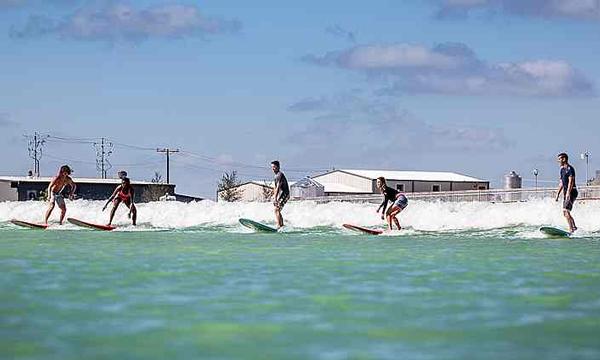SURFING HEADS INLAND, TO AUSTIN, TEXAS
NLand, the first artificial surf park in North America, opened in landlocked Austin last month, inspiring a new generation of surfers who live miles from the ocean
I wasn’t surprised when I wiped out on my first wave. I hadn’t surfed in over a decade, but my body remembered the physical sensation before I slipped off my board and barrel-rolled under the tide. The familiar aftershock of stinging eyes and accidental gulps of salt water, however, were strangely absent. That’s because I was hundreds of miles from the ocean, surfing in a freshwater lagoon surrounded by Texas cattle ranches.
NLand Surf Park, the first artificial surf park of its kind in North America – and the largest in the world – opened last month in Austin, Texas. (Unfortunately NLand closed again for repairs soon after my visit when damage was discovered under the lagoon, though it should reopen by the end of the year.)
“People here are dying for waves. It’s exciting for surfing, and for Austin,” NLand’s Chris Jones told me when I arrived for a surf session two weeks after the park’s opening.
As we approached the water, park officials relayed news that NLand had just generated its 10,000th wave.
Surfers have dreamed of expanding surfing beyond the ocean for decades, according to Doug Coors, NLand founder and heir to the Coors beer dynasty. “Unfortunately,” he added, “all previous attempts failed – water is a tricky molecule, so it isn’t a simple proposition.”
At first glance, Austin seems an unlikely site for a surfing mecca. But Coors, an engineer by trade, saw in the Texan capital an ideal combination of factors: it’s the US’s fastest-growing city, with a booming tech scene and a reputation as an innovative bellwether; locals are famously active and outdoorsy; and it has more than 300 days of sunshine a year.
After years of searching for technology to replicate ocean waves, Coors partnered with Wavegarden, the Spanish engineering company that designed the world’s first wave foil, in Snowdonia, Wales. Starting last summer, the team dug a lagoon the size of nine football fields, with a capacity for 11 million gallons of water, which could take more than 120 surfers at a time. A unique rainwater collection and filtration system makes the pool completely self-sustaining even during extreme drought. The engineering marvel set in 160 acres of Texas hill country has a surreal, almost mirage-like mystique.
“A perfect wave comes in every two minutes, with chances to grab 20- to 30-second rides,” says Ben, one of several surf guides who moved to Austin to work at NLand. “It’s impossible to get that predictability anywhere in the ocean.”
NLand’s wave foil bisects the lagoon beneath a pier that doubles as a boardwalk for spectators. Imagine a snowplough attached to a gantry, propelling a ribbon of waves back and forth, from gentle whitewater to head-high, Waikiki-style barrels.
The consistency of the waves makes it an ideal training space for pros looking for a deliberate form of practice, and a risk-free introductory setting for apprehensive beginners. And, of course, there are no jellyfish or sharks, no undertow, and no jagged coral lurking beneath the waves.
During my one-hour session, I surfed alongside pre-teen sisters in matching wetsuits, a world champion wakesurfer, and middle-aged men reviving a former pastime as a new exercise regime. Afterwards, whether I was strolling along the boardwalk, browsing the surf shop or grabbing a smoothie at the farm-to-table cafe, every conversation centred on excited retellings of someone’s moments on the water.
Surfing’s popularity shows no sign of abating. Pro legend Kelly Slater debuted his own open-barrel wave machine this year. Three Australian surf parks are in development and Surf Snowdonia was recently announced as a UK Pro Surf Tour stop, making it the first manmade lagoon sanctioned by the competitive circuit. At the 2020 Tokyo Games, surfing will become an official Olympic sport – and attract even more followers.
The ocean will always possess an unparalleled majesty, but artificial wave proponents hope places such as NLand can inspire previously unreached populations.
“Seeing first-timers learn here is the beginning of a virtuous cycle,” said Chris Jones. “A whole new generation will be able to say they grew up surfing.”
• Nland Surf Park is currently closed for repairs but hopes to reopen by the end of 2016. Sessions from $60


